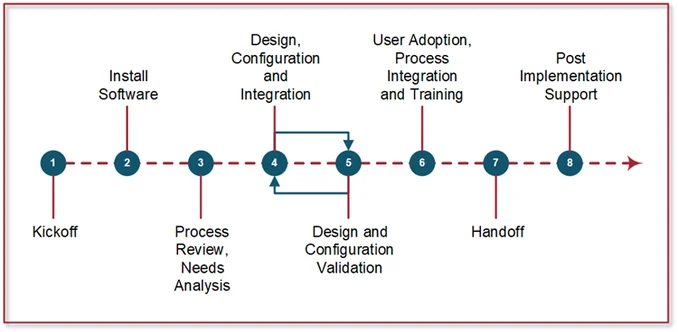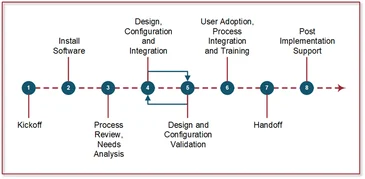Implementing a new proposal software tool such as BOEMax for your proposal teams? Having a software implementation plan in place helps to ensure you take full advantage of the tool’s functionality to improve your proposal process. The software should support your proposal process and help your proposal teams create quality cost estimate data easier and faster.
A software implementation strategic plan and a task list or schedule with defined resource requirements helps you focus on end objectives, set priorities, and identify risks so you are prepared to handle issues that may surface. A primary consideration should be the impact on the proposal teams. When people don’t know how to use proposal writing software or become frustrated and resort to how they have done things in the past, you have lost the benefit of implementing the new software tool.
Where to Start
Ask about the software vendor’s implementation methodology. As an example, typical steps that ProjStream follows to help clients implement BOEMax proposal software are illustrated here.

This can be a useful starting point to plan a basis of estimate software implementation. Flesh out the likely implementation activities and figure out what resources you need – this is often a combination of internal and vendor provided resources.
Your internal resources should have an in-depth understanding of your business needs, process, and systems. The software vendor will rely on these people to help them configure the bidding software to align with your business environment. This can range from simple software configuration settings to more complex data architecture design. This can include creating user defined fields or codes, setting up core base data such as calendars and rates, importing source data from other systems to build up the basis of estimate database, establishing a variety of templates, setting up data maps to enable functions such as cost and schedule integration, and creating custom data views or reports.
Establish a time frame for the proposal writing software implementation and identify business priorities. This can help determine the scope of what you may be able to achieve by a given target date. With the appropriate up-front planning, you can often quickly execute the initial software implementation steps in a few days and then focus on process updates and helping the proposal teams adapt to the new software.
A common best practice is to select a candidate proposal so you can work through the software learning curve. That way you can figure out the best configuration for your business environment, verify functionality, and identify where basis of estimate software could help streamline your current proposal process. What would help your proposal teams save time or improve the quality of the data? What would help increase management visibility and control?
Identify Opportunities to Improve Your Proposal Process
New proposal software tools are often purchased under the assumption they will magically fix issues with the proposal process. Not true. You will need to do your homework to determine how you can take advantage of software functionality to address the business issues that caused you to look for a software solution in the first place.
Let’s look at three examples and likely estimate software implementation planning activities.
Example 1 business issue: the proposal teams can’t easily access historical estimate and actual cost data or common bills of material (BOMs) they can use to substantiate their cost estimates.
This is where proposal software tools such as BOEMax can help. You can take advantage of the Process Library function to create process templates of common tasks with resource requirements and labor hour or direct cost details. You can easily import data from other systems to build up these templates proposal teams can search and copy into their projects. Or, you can create a master part and component list that proposal teams can select from to create their proposal specific BOMs. As the proposal teams create their cost estimates over time and enter their basis of estimate rationale in the database, this automatically creates additional useful source data proposal teams can search and copy.
To take advantage of this functionality, you could add tasks in your implementation schedule to create templates in BOEMax as well as import source data from other systems such as actual costs or BOM data. You have addressed your business issue because the proposal teams can easily access the credible source data they need to create data driven cost estimates. This improves the accuracy of the proposal cost estimates and increases management’s ability to determine the likely profit margin.
Example 2 business issue: lack consistency in how proposal teams apply rates and it is difficult to verify the rate set used to calculate the cost estimate direct and indirect costs.
Depending on your environment, this may entail additional homework to develop a data architecture model for the proposal software database to revamp how you structure your data. Perhaps attributes can be added to the resource structure or rate results set up to match your business needs. This can often help to simplify or reduce the volume of data you need to maintain or eliminate redundant data entry. Rate and resource structure templates or global structures could be set up to address the consistency issues so it is easier to maintain approved common core data for the proposal teams.
For this example, you may need to add business process engineering tasks in the implementation schedule along with other activities to establish common rate templates in BOEMax that are actively maintained. This is a more significant change to your proposal process with the intent of simplifying things for the proposal teams and management has confidence the proposal teams are always using the current approved set of rates.
Example 3 business issue: cost estimators are making “stealth” changes to the cost estimate; the proposal manager can’t track who is making changes because the estimators aren’t following the proposal manager’s process to manage changes.
BOEMax bidding software can help with this because proposal managers can either implement the built-in workflow process to manage the proposal development process or switch on the automatic audit log function. They can quickly identify and track who made changes to what work elements. This business issue could be addressed as part of the software configuration activity. The proposal manager would set up their desired sequence of workflow approvals or simply enable the audit log option in BOEMax.
For all these examples, the proposal process will need to be updated. You may also want to create new work instructions, so proposal teams know how to effectively use the estimate software. Allow time in your software implementation schedule to make these process changes and train key personnel.
User Acceptance
This is where the implementation of a new basis of estimate software often goes down in flames. Without user acceptance of the new tool and any related process changes, you are wasting time and money. User acceptance is often overlooked or isn’t identified as a critical success factor.
Avoid conducting a “training” class where an instructor drones through a PowerPoint presentation or demonstrates the features and functions of the software. This is a waste of time.
Take a more strategic approach to involve the proposal team personnel. Identify people who are influencers or “power” users and include them in the implementation process. They should be included in the business process review. They can often identify opportunities to leverage proposal software functionality that simplifies their usual proposal tasks you wouldn’t have thought about.
Let them take ownership, create targeted training that integrates process and using the software to accomplish proposal tasks, and produce work instructions for the proposal teams. They can also help you set up project templates and global structures. The proposal teams can then use these templates to reduce the time and effort required to create proposal projects as well as improve the quality of the cost estimate data.
Ready to get started with your proposal software implementation? Contact us to schedule a proposal software demo. ProjStream can help you with your implementation planning, work through your business issues, and configure BOEMax to align with your improved proposal process.
